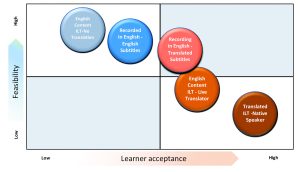
Feature Story – Tim Greiner
Cost-effective options help to connect global colleagues
When training globally, especially for an audience that includes people both inside and outside your organization, there are a lot of choices that need to be made.
- What delivery format works for everyone?
- How will you manage the time zone difference?
- Does everyone speak and learn in the same language?
It can be overwhelming. It’s certainly too much to address in this short article, so let’s look at just one of the challenges – language – and explore a bit further.
Balancing the Budget, and the Need
To begin solving the problem, you must understand more about what your learners need. Consider the following valuable takeaways from a recent survey:
- Most learners in business settings have some ability to read and understand English.
- However, it is difficult for them to grasp the message by listening to a native English speaker.
- Many are used to having local language subtitles for content spoken in other languages, but 70% to 80% of them could not do the same with English subtitles.
 There are several options for delivery that include some level of localization, and each has its own relative cost and complexity. For example, it’s much more difficult to take an e-learning module, translate the text and the player interface, re-record the translated narration, and maintain several versions over time, than it is to hire a live translation service for a virtual ILT session. But both have costs.
There are several options for delivery that include some level of localization, and each has its own relative cost and complexity. For example, it’s much more difficult to take an e-learning module, translate the text and the player interface, re-record the translated narration, and maintain several versions over time, than it is to hire a live translation service for a virtual ILT session. But both have costs.
Once you determine the costs of the options and the needs of your learners, you can map out the options in a way that illustrates their viability. Figure 1 illustrates several translation options in terms of their feasibility and cost and of the learners’ likely acceptance.
Based on your organization’s resources, you can identify options that are cost-effective enough and sufficiently address the need.
When You Find What Works, Standardize It
Armed with this new understanding, you can build solid experience in producing the materials that satisfy the need. Over time you can come to know what processes work best for translation and review, what parts of the work are best done in-house and what suppliers were the most responsive and cost-effective for the outsourced work.
With enough practice, you can streamline the process such that all new materials are created for multilingual audiences by default with nominal additional cost and no delay in release.
Is There a Wider Lesson Here?
I remember being told a story about a king who challenged two of his lords to create a toy mouse for his beloved cat. The creator of the best toy mouse (as measured by the cat’s preference for it) would receive great wealth and fame.
The first lord brought a magnificent, elaborately crafted mouse of silver and jewels. This technical marvel was filled with gears and springs and could move across the floor to give the cat a chase. Certain he would win, the first lord presented his creation proudly.
The second lord assembled his gift from scraps of fur over a mostly-mouse-shaped wooden base. It smelled faintly of fish and lacked any ornate embellishments. Upon seeing this, the first lord laughed, knowing his victory was certain.
No doubt you can guess the rest. I thought of this story while on my own localization journey where we learned that the elaborate, expensive, difficult-to-maintain approach wasn’t necessary. And we’re all much happier cats now!
Tim Greiner is the senior director of USP education for the United States Pharmacopeial Convention. Email Tim at tag@usp.org.









